Dear Vanniya Sonthangale!!!
PALLAVA DYNASTY
History
The following chronology is accumulated from the three charters:
| Simhavarman I 275 - 300 CE |
Simhavarman II 436 - 460 CE |
| Skandavarman |
Skandavarman IV 460 - 480 CE |
| Visnugopa 350 - 355 CE |
Nandivarman I 480 - 510 CE |
| Kumaravishnu I 350 - 370 CE |
Kumaravishnu II 510 - 530 CE |
| Skandavarman II 370 - 385 CE |
Buddhavarman 530 - 540 CE |
| Viravarman 385 - 400 CE |
Kumaravisnu III 540 - 550 CE |
| Skandavarman III 400 - 436 CE |
Simhavarman III 550 - 560 CE |
| Mahendravarman II 668 - 672 CE |
Nandivarman II (Pallavamalla) 732 - 796 CE |
| Paramesvaravarman I 672 - 700 CE |
Thandivarman 775 - 825 CE |
| Narasimhavarman II (Raja Simha) 700 - 728 CE |
Nandivarman III 825 - 869 CE |
| Paramesvaravarman II 705 - 710 CE |
Aparajitha Varman 882 - 901 CE |
Pallava
Dynasty was a pastoral tribe who ruled the southern parts of India for
almost 500 years. Pallava dynasty conquered the region of
Thondaimandalam that was located at Pallavapuri, The Pallava rulers
established their kingdom on the ruins of the eastern part of the
kingdom of the Satvahanas. They originally worked as officials under the
Satvahana rulers, in the course of time they established themselves as
local rulers. Very rapidly their kingdom spanned parts of southern
Andhra Pradesh and northern Tamil Nadu. Pallavas established their
capital at Kanchi (modern Kanchipuram near Chennai), which gradually
became popular and famous for its temples and as center of Vedic
learning.
|  |
Pallavas territory extended from Northern Odissi to Tanjore and Trichi
in far south. They were great conquerors and left a huge impact in the
field of art and architecture. The Pallava Dynasty fought many wars
with the Chalukyas (to the northwest) and the Pandyas (to the south).
Both of these states -Chalukyas and Pandyas tried their best to stop the
Pallavas from rising, but failed. The Pallava Empire continued to live
on until the 13th century AD. Around 14th century A.D, the Pallavas
defeated the Ikshvakus and spread their territory as far as the River
Krishna.
Administration
Simha
Vishnu is the founder of Pallava dynasty and is considered to be a very
efficient and strong conqueror. After Simha Vishnu death, his son
Mahendravarman (571 – 630 CE ) became the king. He was a very efficient
ruler and a learned man. The construction of the famous cave temple at
Mahabalipuram was his initiation. However, the tales of prosperity of
Pallava dynasty reached far and wide and Chalukya Pulakesi-II learnt
about the richness and abundance of the kingdom. Chalukya attacked the
kingdom and defeated Mahendravarman.
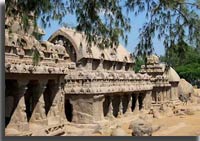 |
In
the battle the defeat was the main cause for the death of
Mahendravarman. After him Narasimhavarman his son ascended the throne.
He vowed to take revenge for the death of his father. He was a well
built man who was also very intelligent. With much planning and tact, he
virtually destroyed the kingdom of Chalukya Pulakesi. Later
Narasimhavarman continued the construction of the cave temple which was
stalled temporarily. Dandin the Sanskrit writer was his court poet.
Kailasnatha and Vaikuntha Perumal temple of Kanchi known for beautiful
sculptures were extended during the period of Narasimhavaram (700-728
CE). He was given the title of "Mamalla", which could be the reason why
Mahabalipuram is also known as Mamallapuram. He got many temples
constructed all over his kingdom
|
Place
|
Chennai, Andhra Pradesh
|
Period
|
4th to 9th century CE
|
Language
|
Tamil
|
Religion
|
Hinduism
|
Rulers
|
Mahendravarman I, Narasimhavarman I, Nandivarman I, Simhavishnu, Paramesvaravarma I
|
| 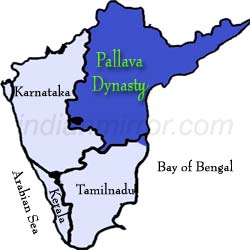 |
Society
The
society in south India is more of caste ridden, like that in north
India. The Brahmins (priestly class) and Kshatriyas (warrior class)
dominated the people belonging to the lower castes. Their position was
on the rise as the rulers began to grant land to temples and important
priests. Religion played an important part in the life of the people in
the kingdom. Hinduism held sway in the kingdom and Vedic sacrificial
rights were common.
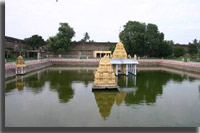 |
The
cult of Lord Vishnu and Lord Shiva became important during the period
of Pallava dynasty and Kanchipuram became an important pilgrim center
for the Hindu devotees. Kanchipuram, the capital of the Pallavas, also
became an important center of Tamil and Sanskrit studies. The temples
became not the only places of worship, but they became important
cultural and administrative centers where festivals were held and people
also gathered in the temples to solve local problems, as the temples
governed large areas of land and the people thereof.
|
Art
The rulers of the Pallava kingdom were not only great warriors, but
also were great patrons of art and architecture. The Pallava kings built
a number of important temples in 17th and 18th centuries AD. The large
rock-cut temples at Mahabalipuram are magnificent examples of the
architectural prowess of the artisans of that time. Temple architecture
reached its magnificent heigths in ancient India when the Kailashnath
temple at Ellora was built in the 8th century.
| 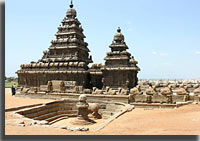 |
Culture
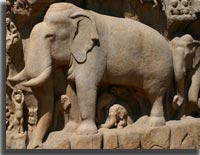 |
Pallava
Dynasty was rich in various cultural aspects including dance, art, and
music. Evidence of dancing among the Pallavas has been found painted on
the walls of temples, caves and depicted by sculptures. Different poses
are depicted and there were individual dances as well as group dances
for both men and women. Dancing is the form of entertainment frequently
employed in the king’s court, as well as temples.
|
Dancing
was used as a form of worship; Siva is depicted in the dance called
tandava. The principal hobbies of the prince and princesses of the
Pallava Dynasty was painting. The walls of the cave temples gave a
partial look into this art form and paint can be seen in traces of rich
colors. They Pallava dynasty used vegetable colour so the available
colors were few, but they included red, yellow, green, and black.
| 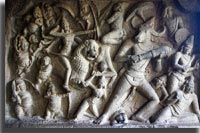 |
The
Kailasanatha temple contains nearly fifty cells around the inner
courtyard and each of them shows traces of painting. Music also had a
prominent place in Pallava society and songs were not only used to
praise deity, but even to praise rulers as well. The songs sang their
praises and spoke of their individual genius and skill.
Rise of
Rashtrakutas had seen the decline of Pallavas. Vijayalaya the Chola
king, completely vanquished Aparajitavarma the last Pallava king in 890
AD
.
|
No comments:
Post a Comment